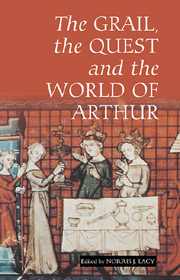Book contents
- Frontmatter
- Contents
- List of Illustrations
- Notes on Contributors
- Foreword
- Introduction: Arthur and/or the Grail
- 2 The Shape of the Grail in Medieval Art
- 3 The Crusaders' Grail
- 4 Bounds of Imagination: Grail Questing and Chivalric Colonizing in Wolfram von Eschenbach's Parzival
- 5 The Land without the Grail: A Note on Occitania, Rigaut de Barbezieux and Literary History
- 6 Female Desire and the Quest in the Icelandic Legend of Tristram and Ísodd
- 7 Questing in the Middle Dutch Lancelot Compilation
- 8 Keeping Company: Manuscript Contexts for Reading Arthurian Quest Narratives
- 9 Grail and Quest in the Medieval English World of Arthur
- 10 Malory and the Grail: The Importance of Detail
- 11 Glastonbury, the Grail-Bearer and the Sixteenth-Century Antiquaries
- 12 The Grail Quest: Where Next?
- Appendix: The Grail on Film
- Index
- Analysis of grail scenes
- Arthurian Studies
Foreword
Published online by Cambridge University Press: 05 February 2013
- Frontmatter
- Contents
- List of Illustrations
- Notes on Contributors
- Foreword
- Introduction: Arthur and/or the Grail
- 2 The Shape of the Grail in Medieval Art
- 3 The Crusaders' Grail
- 4 Bounds of Imagination: Grail Questing and Chivalric Colonizing in Wolfram von Eschenbach's Parzival
- 5 The Land without the Grail: A Note on Occitania, Rigaut de Barbezieux and Literary History
- 6 Female Desire and the Quest in the Icelandic Legend of Tristram and Ísodd
- 7 Questing in the Middle Dutch Lancelot Compilation
- 8 Keeping Company: Manuscript Contexts for Reading Arthurian Quest Narratives
- 9 Grail and Quest in the Medieval English World of Arthur
- 10 Malory and the Grail: The Importance of Detail
- 11 Glastonbury, the Grail-Bearer and the Sixteenth-Century Antiquaries
- 12 The Grail Quest: Where Next?
- Appendix: The Grail on Film
- Index
- Analysis of grail scenes
- Arthurian Studies
Summary
To suggest that the quest was a pervasive theme in Arthurian (and other) literature of the Middle Ages seriously understates the matter. Quests and adventures are the very essence of romance. Moreover, multiple adventures occur frequently in the course of a quest, almost as if the quest has as one of its purposes to provide the very narrative space within which adventures can occur, often at great length and in extended sequences. The suggestion that the quest either permits or sponsors adventures is supported in texts such as the French Vulgate Cycle of the thirteenth century: in that cycle and others, the conclusion of the quest also ends adventures and marvels, leaving little for Arthur and his surviving knights to do except hold tournaments, eventually become embroiled in a war between comrades and friends and finally end in the tragic fall of Camelot and the death of Arthur – if he did indeed die.
The chivalric quest itself, whether Arthurian or other, was most often a highly structured and heavily conventionalized process. Douglas Kelly summarized some of the conventions in an article dealing with multiple quests: ‘the knight will usually grant mercy to a defeated opponent, refuse to halt more than one night before achieving his quest, preserve his incognito, and respond to any challenge.’ The Grail quest, in many cases, adds its own conventions to the more generalized ones. Once it is known that a quest for the Grail will be undertaken, a knight who is most often Gawain/Gauvain impulsively swears to search for the Grail for a year and a day and never stop until he is successful – which he is only in rare instances.
- Type
- Chapter
- Information
- The Grail, the Quest, and the World of Arthur , pp. xv - xviiiPublisher: Boydell & BrewerPrint publication year: 2008



